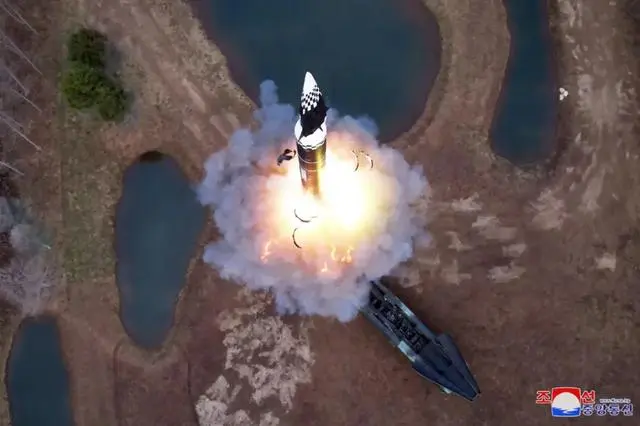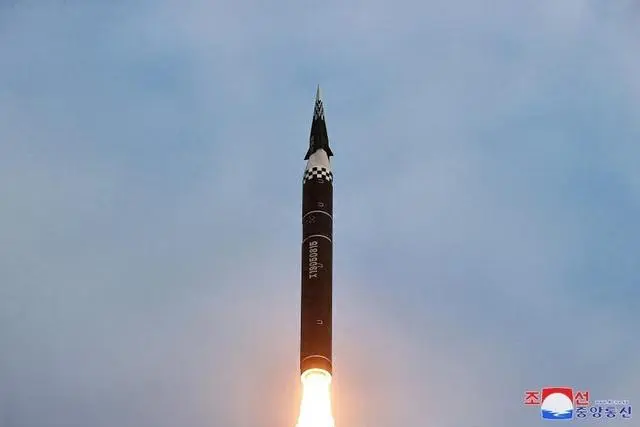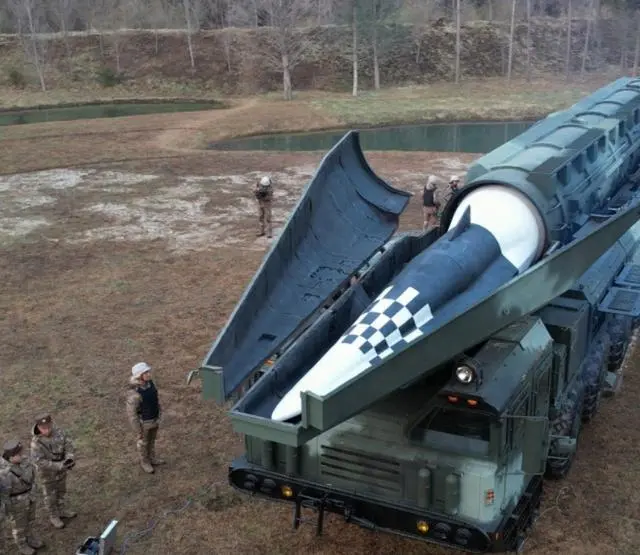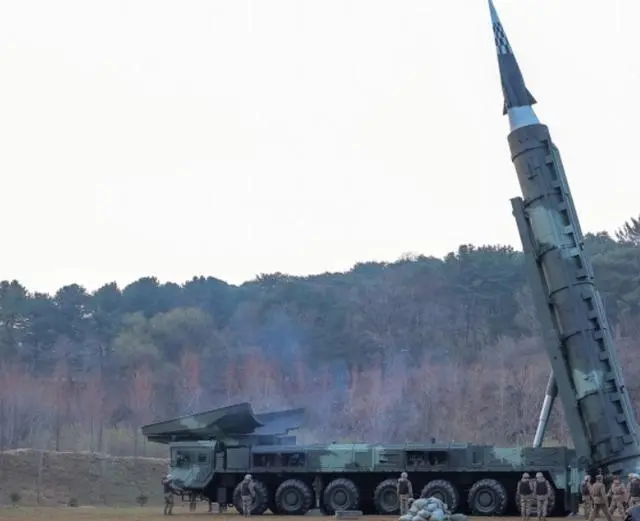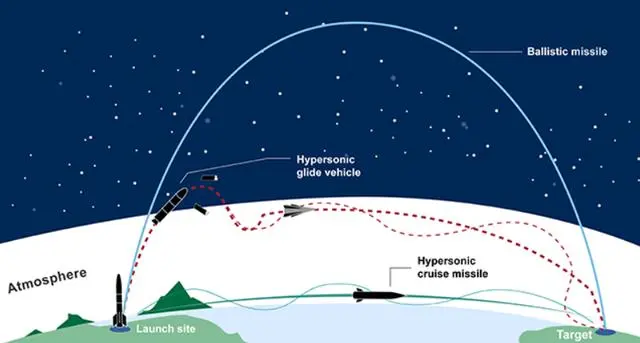Just a few days ago, North Korea announced the successful test launch of its second-generation intermediate-to-long-range hypersonic attack missile, becoming the third country to steadily advance in the hypersonic domain after China and Russia. This achievement is remarkable, as the United States has yet to achieve such a level of hypersonic missile testing.
From relevant reports, North Korea referred to the new type of intermediate-to-long-range hypersonic attack missile as the Hwasong-16B, although it has no direct connection to the Hwasong-16 intercontinental missile that utilizes an 11-axle launch vehicle. The Hwasong-16B employs a 7-axle missile launcher vehicle, making its size roughly equivalent to that of the Soviet-era RSD-10 intermediate-range ballistic missile (NATO reporting name SS-20 “Saber”).
The Hwasong-16B missile utilizes a two-stage solid rocket motor, with the hypersonic warhead being a glide vehicle. Before the missile is erected, the warhead is protected by a three-piece cover, which is opened when the missile is erected to avoid environmental interference. Due to its advanced glide vehicle design, the Hwasong-16B’s warhead has a significant lift-to-drag ratio, allowing it to maneuver extensively within the atmosphere to evade detection and interception by adversary missile defense systems.
Due to the substantial weight and volume design of the hypersonic warhead, it somewhat affects its range, despite having two-stage rocket propulsion. Although the exact range is not as optimistic, the test launch range of the Hwasong-16B missile was approximately 1,000 kilometers. North Korea explained that, for safety reasons, the Hwasong-16B delayed the ignition of the second-stage rocket motor and conducted high-G maneuvering in the test area to control speed and altitude, thereby avoiding flying over neighboring countries’ airspace.
Considering the trajectory of the Hwasong-16B’s flight test, the shutdown speed of the missile is preliminarily estimated to be as high as Mach 12, with a maximum range exceeding 3,500 kilometers. This range is sufficient to cover the entire Korean Peninsula and Japan, including Guam within its striking range. If North Korea intended to conduct such a full-range flight test, the missile would inevitably fly over Japanese airspace. Considering the complexity of the current Northeast Asian situation, North Korea deliberately restricted the missile’s range.
Such advanced ballistic control capabilities also demonstrate North Korea’s technological prowess in this field. The primary characteristic of hypersonic attack missiles is their unpredictable trajectory, making them difficult to detect and intercept using traditional air defense systems.
Previously, when North Korea unveiled the Hwasong-8 hypersonic attack missile, the United States, Japan, and South Korea were skeptical, with some even mocking it as a “token model.” However, through subsequent missile tests, North Korea demonstrated its ballistic missile control capabilities. In 2022, North Korea conducted multiple hypersonic attack missile tests, which were carefully observed by the United States, Japan, and South Korea, providing them with an opportunity to analyze and assess North Korea’s technological capabilities.
According to observation data, North Korea’s hypersonic warhead made “sharp turns” before splashing down into the sea. Faced with facts, the United States, Japan, and South Korea had to admit that North Korea had made significant progress in the field of hypersonic attack missiles, even surpassing the United States.
In this test launch of the Hwasong-16B, North Korea once again demonstrated its advanced control capabilities. After reaching an altitude of approximately 100 kilometers, the Hwasong-16B missile released its hypersonic attack warhead, which maneuvered after gliding down to an altitude of about 70 kilometers. This altitude coincides with the low boundary of the Standard-3 anti-missile interception missile.
The Standard-3 anti-missile interception missile is the backbone of the anti-missile defense systems of the United States, Japan, and South Korea, playing a crucial role in mid-course interception tasks. The United States and Japan hope that the Standard-3 can intercept most missiles in the mid-course phase, thus avoiding significant damage to the ground and reducing pressure on inner-layer defense systems, thereby improving the overall interception efficiency of the missile defense system. Therefore, in its design, the minimum interception altitude of the Standard-3 anti-missile interception missile is set at 70 kilometers.
The hypersonic warhead of the Hwasong-16B missile presses the lowest point of its gliding trajectory at 70 kilometers, effectively avoiding interception by the Standard-3 anti-missile interception missile, posing a significant challenge to the missile defense systems of the United States, Japan, and South Korea.
The successful development of the Hwasong-16B represents another major breakthrough for North Korea in missile technology.
Firstly, it signifies North Korea’s transition from liquid to solid propulsion in missile development. Previously, North Korea’s first hypersonic attack missile, the Hwasong-8, used liquid fuel rocket engines, requiring fueling before launch, making it vulnerable to attack.
The Hwasong-16B employs solid rocket motors, allowing for long-term storage and immediate launch upon receiving commands, thereby enhancing safety, responsiveness, concealment, and battlefield survivability.
Secondly, significant progress has been made in the development of the hypersonic attack warhead, with the range of the Hwasong-16B missile exceeding 3,500 kilometers. For missiles, longer ranges and higher speeds pose greater challenges in the development of guidance systems, control systems, and thermal protection.
Overcoming these technological challenges is extremely difficult—even the United States finds it daunting. Given North Korea’s limited economic and technological capabilities, its ability to overcome these challenges is truly impressive.
North Korea is under intense military pressure from the United States, Japan, and South Korea, making it difficult to match their conventional combat capabilities. In this situation, long-range missiles have become one of North Korea’s few and reliable asymmetric means of attack, bearing the responsibility of deterring powerful adversaries.
However, in recent years, the United States, Japan, and South Korea have been intensifying efforts to build anti-missile defense systems in Northeast Asia, attempting to contain the missile attack capabilities of China, Russia, and North Korea. In this context, North Korea’s focused development of hypersonic attack missiles can effectively break through the anti-missile encirclement of the United States, Japan, and South Korea. It can be foreseen that in the future, North Korea will further enhance the performance of the Hwasong-16B or equip hypersonic flight bodies on more intermediate-to-long-range missiles to comprehensively improve its deterrence capabilities against the United States, Japan, and South Korea.
